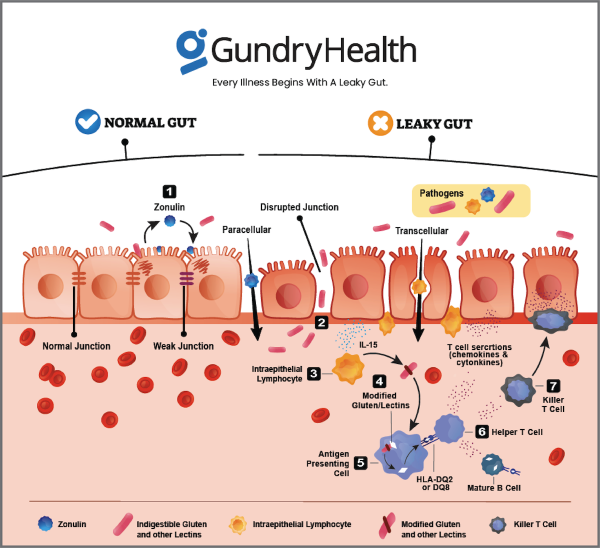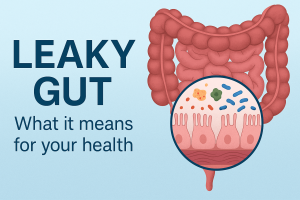Diabetes: Can it Be Reversed? Dr. Steven Gundry Explains Diabetes Symptoms and How to Treat Diabetes
Find out the difference between type 1 and type 2 diabetes, how diabetes affects the body, and the best way to treat diabetes
Is diabetes an autoimmune disease?
Over 11% of American adults have been diagnosed with diabetes. More shocking still, some 96 million Americans 18 and older have prediabetes (the condition leading to type 2 diabetes). This means close to 1 in every 2 American adults is diabetic or prediabetic!
And the first thing you need to know about diabetes is that there are 2 types.
Making Hard, Easy.
Type 1 diabetes is an autoimmune disease
This means in people with type 1 diabetes, their immune system attacks the body from within and destroys the pancreatic cells producing insulin.
Insulin is a hormone responsible for controlling the amount of sugar (glucose) in your bloodstream. So without the right amount of insulin, people with type 1 diabetes can’t get the energy they need to their cells.
Type 1 diabetes is often called juvenile diabetes because it’s commonly diagnosed in children and teens. (More on one surprising cause of type 1 diabetes below.)
What is Type 2 Diabetes?
By contrast, type 2 diabetes happens when your body becomes resistant to insulin. This means your cells can no longer use glucose from your blood to make energy.
And until very recently, most medical professionals (including Dr. Gundry) agreed that type 2 diabetes was a metabolic disorder. A metabolic disorder occurs when your body has a chemical imbalance and certain functions – like metabolism – no longer work the way they should in a healthy body.
However, this traditional view has begun to change in recent years. In fact, type 1 and type 2 diabetes may be more related than previously believed.
Some researchers now believe insulin resistance (type 2 diabetes) may result from the immune system attacking the body’s own cells. This is a classic hallmark of autoimmune disease.
Surprising causes of diabetes
Think of insulin like a “salesman” who sells sugar and protein to the “customer” cells in your body. The salesman must get the sugar out of your bloodstream or they don’t get paid.
So, the salesman insulin rings the doorbell on your cells’ doors. But the presence of dangerous compounds called ceramides blocks the ability of insulin receptors on your cells to detect insulin outside.
They can’t hear the doorbell ring, in other words. And without picking up that signal, your cells don’t “open up” to let sugars and proteins in for processing.
And as the sugars and proteins begin to back up inside your body, your pancreas starts pouring more insulin into the bloodstream, trying to signal louder and louder to your cells to open up the doors.
The result is plummeting energy levels (since your cells can’t get the sugar they need to transform it into energy) and skyrocketing blood sugar and insulin levels.
But what causes this to happen?
In the case of type 1 diabetes, the most common form of diabetes in children and young people, one possible cause may surprise you: cow’s milk.
The reason is a particular type of protein found in around 95% of American cow’s milk called casein A-1. During digestion, casein A-1 ids turned into a harmful protein called beta-casomorphin. This protein attaches to your pancreas’s insulin-producing cells, causing an immune attack on the pancreas.
And remember, your pancreas produces insulin. So when it’s under attack, your pancreas can’t produce the right amount of insulin to help regulate your body’s blood sugar levels. The result? Type 1 diabetes.
The cause of type 2 diabetes is just as complicated.
What Causes Insulin Resistance?
However, to explain what may be behind the rise in type 2 diabetes, you must first understand metabolic flexibility. This simply refers to your body’s ability to get fuel from whatever fuel source is available to it.
Metabolic flexibility is the cornerstone of a healthy energy system and of all health and longevity. Without it, your energy production can start to break down.
And being metabolically flexible means your energy-producing factories (called mitochondria) can keep your body and brain powered even when one type of fuel (like sugar) runs out. When there’s no sugar around, a metabolically flexible body can shift to breaking down extra fuel you’ve stored in your fat cells.
However, when you consume too many refined and ultra-processed foods and combine this with a sedentary lifestyle, you have a recipe for insulin resistance and type 2 diabetes.
You see, when insulin levels are already high, it’s difficult for your body to get that “emergency” fuel from stored fat. This can lead to you feeling tired, sluggish, hungry, and “hangry.” And you soon may become even more insulin resistant.
The culprit of diabetes: leaky gut
Like many autoimmune diseases, diabetes starts in your gut.
You see, the immune cells along your gut lining play an important role in keeping your gut wall strong. They decide what can leave the GI tract and what must stay contained.
When everything is working well, nothing gets through this strong gut barrier except what’s supposed to. However, when this barrier gets worn down (more on that below) and develops more and more microscopic holes, it allows other compounds to “leak” through, causing your health to suffer.
This is the condition known as “leaky gut.”
Here’s another way to think about it…
Imagine your body is a fortress. You need a wall to protect yourself. That’s your gut wall. Immune cells are the soldiers there to protect your fortress. Their job is to detect friend from foe. And when they fight for you, they cause collateral damage. We call that collateral damage inflammation.
However, your protective walls aren’t sealed shut. All along the wall are tiny doors. And while these doors are closed most of the time, sometimes they need to open to allow food or friends to come in.
So imagine what would happen if those doors were always open. It would be much harder for your soldiers to defend the fortress (your body). Now, there is a molecule (called zonulin) inside your body that makes these “doors” in your gut wall open or close. And there are certain environmental triggers that make your cells produce zonulin.
One of these “triggers” is gluten. Humans, it turns out, were never meant to eat this food. And for most of human history, we didn’t. But once humans stopped living a hunter-gatherer lifestyle and started farming, gluten became a staple of our diets. Which might not have been a problem, except for one thing.
You see, gluten has certain protein “fragments” that humans can’t digest. Because of that, these “fragments” communicate with the soldiers on your gut wall and say, “Please, release zonulin and let us in.” Your immune system, though, thinks these proteins are invaders and starts fighting back. This causes inflammation.
Long-term inflammation like this – particularly in the pancreas – can lead to problems like insulin resistance and diabetes.
Am I Pre-Diabetic? Signs of Diabetes
One key sign of diabetes is low energy.
When your body can no longer easily convert glucose from food into energy (or transform fat into energy), it’s usually a sign of poor metabolic health and high insulin levels. Put simply: low energy is a classic sign of prediabetes or type 2 diabetes.
In addition to sluggishness and low energy, other signs of diabetes may include excessive urination, feeling hungry or “hangry,” excess thirst, and irritability.
If you are concerned you may be at risk, check your most recent blood work for your fasting blood sugar and HbA1c levels (or talk to your doctor about getting these tested). Fasting blood sugar levels above 100 or an HbA1c level 5.7 or higher may indicate prediabetes or diabetes.
Can diabetes be reversed? Dr. Steven Gundry says it can
By now, the science is clear: type 2 diabetes is largely driven by diet and lifestyle factors. That means the key to treating diabetes starts with the food you eat.
If you do suspect you may have diabetes, or if you’re already suffering from symptoms of diabetes like constant low energy, there are some steps you can take right at home.
Dr. Gundry always begins with blood work. He looks not only at traditional markers of diabetes like your fasting blood sugar level or your HbA1c levels, but he also takes a close look at possible food sensitivities. (For example, some of his patients are particularly sensitive to a class of proteins called lectins that can weaken the lining of your gut wall.)
Pre-Diabetic, Type 1 Diabetes and Type 2 Diabetes Treatment Plan
Next, Dr. Gundry has his diabetes patients begin his specific dietary program. While this includes cutting sugar (including most fruit) from the diet, it also includes cutting other inflammatory foods like lectins (and in some particularly sensitive patients, dairy). However, Dr. Gundry’s program is not an elimination diet, nor is it about depriving yourself or feeling hungry.
Patients who start this program are often amazed by the results, and many of them have eliminated their diabetes altogether (with the lab results to prove it).







